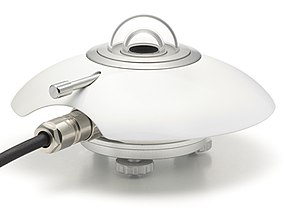How Energy Monitoring Systems...
18/07/2025
Blogs

Pyranometer- Why to measure accurate solar irradiance ?
The Solar Radiation Sensor, or solar pyranometer, measures global radiation, the sum at the point of measurement of both the direct and diffuse components of solar irradiance.
In-plane irradiance received by the PV array is one of the most important and significant factors that directly impacts the PV Performance. Irradiance must be measured accurately to determine your optimal PV performance ratio.
Our pyranometers ensure the highest accuracy in Irradiance measurements and are suited to provide both-
Global Horizontal Irradiance (GHI) is important because it is the parameter measured in weather and climate networks, derived from satellite instruments and calculated with clear sky energy models.
A pyranometer tilted in the Plane of Array (POA) of the PV modules measures the irradiance available to the cells and is used for calculating energy yield and Performance Ratios. This is why you will often see pyranometers in pairs, one horizontal and one tilted.
The pyranometers are equipped to provide-
Pyranometers are most important part of our automated weather station. Logics PowerAMR Platform supports various reporting features and analysis from pyranometer data-
There are various classification of Pyranometers according to ISO 9060:1990 (E), namely –
Typical Pyranometer comparison is as listed below-
|
Make |
Standard |
Delta Ohm- Class 2 Pyranometer |
Kipp & Zonnen- Secondary Standard ( Class A) |
|
Model No. |
Pyra 300 |
LP PYRA03 |
SMP 10 |
|
Range |
0-1800 W/mxm |
0-2000 W/mxm |
0-3000 W/mxm |
|
Spectral response |
400-1100 nm |
305nm- 2800nm |
270nm-3000nm |
|
Transducer |
silicon photo diode |
Thermopile Type |
Thermopile Type |
|
Accuracy(-+) |
5% |
3% |
2% |
|
Operating temperature |
from -40 to +65 deg. C |
from -40 to +80 deg. C |
from -40 to +80 deg. C |
|
Output |
0-5vdc / 4-20mA/RS 485 |
0-1vdc / 4-20mA/RS 485 |
0-1vdc / 4-20mA/RS 485 |
|
Humidity range |
0-100% |
0-100% |
0-100% |
To get the best deals on Pyranometers, please contact @ 8076963066, Download technical specifications of Pyranometer from http://poweramr.in/download-center
How Energy Monitoring Systems...
18/07/2025
16/07/2025
Real-Time Energy Monitoring: How...
27/06/2025
25/06/2025
Why Wind Monitoring Matters...
24/06/2025

